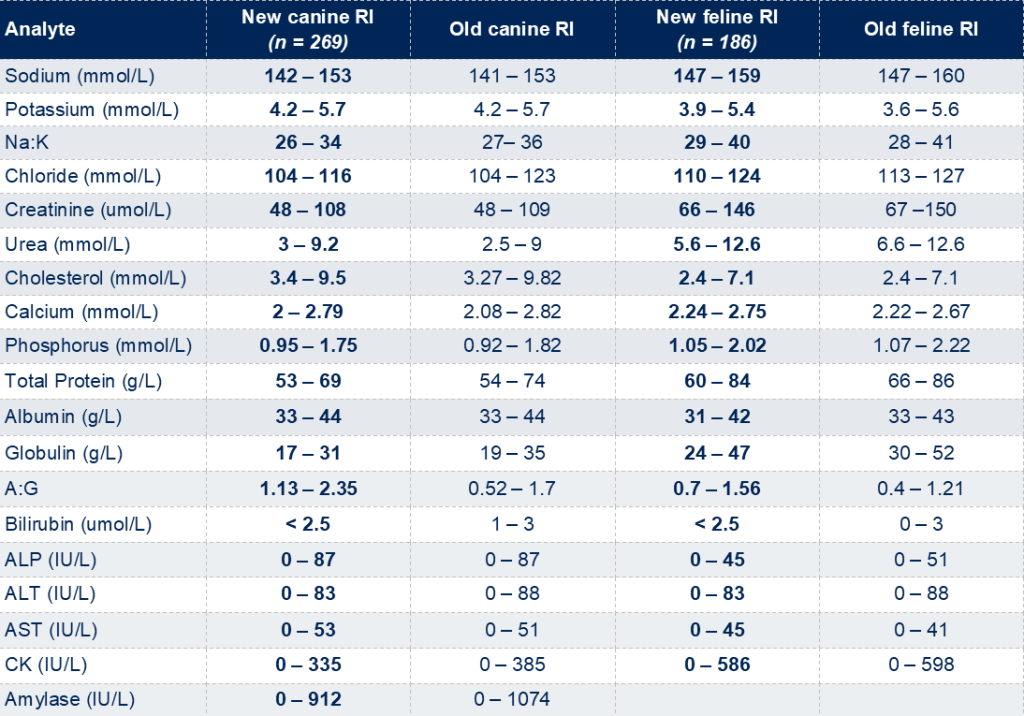Following the successful update of our haematology reference intervals last year, we are pleased to announce the upcoming release of new biochemistry reference intervals for cats and dogs. These updates are the result of two extensive reference interval studies conducted over the past seven years.
These studies would not have been possible without the generous support of veterinary clinics, their clients, and pet owners from across the country. We extend our sincere gratitude to everyone who contributed to this important work.
Many reference intervals commonly used in veterinary laboratories or cited in literature are derived from less representative populations – such as young animals undergoing desexing, or animals from breeding kennels or research colonies. In contrast, our updated intervals are based on a broad and diverse population of companion animals in New Zealand, representing a significant and meaningful advancement.
Below, you will find further information about the studies and the specific changes being made to the reference intervals.
Why have we updated our reference intervals?
Periodic re-evaluation of reference intervals is an important part of good laboratory practice. As time passes, reference intervals may not adequately reflect the animal populations they are meant to represent.
This can be due to changes in breed popularity, de-sexing practices, diet, disease control, genetics and other animal factors. Changing methods of sample collection and transportation to the laboratory can also alter pre-analytical factors and analytical methods may change so that reference intervals are no longer fit for purpose.
What animals were included in the study?
To be included in the studies, animals had to be fasted, clinically healthy, not on any medication or history of vaccination in the previous two weeks, not pregnant, not from an SPCA or pound (i.e. the animals had to have a known clinical history), aged between one and 10 years and for dogs, not sighthounds.
Full biochemistry and haematology panels were run on the samples and any samples with artifact (lipaemia, haemolysis) or signs of disease on the routine testing were excluded from the study. Only samples that reached us within 24 hours were included in the final dataset, to minimise any artefactual changes that may occur due to delayed separation of samples for biochemistry testing.
In total, samples from 269 dogs and 186 cats were included in the final reference sample group. The median age of the dogs was four years old (range: one – 10 years old), 56% of which were female and 43% male. Most dogs (58%) were desexed and 50 breeds were represented, the most common being Labrador retrievers (32 dogs), Border collies (23), Golden retrievers (22), Staffordshire bull terriers (17), Huntaways (17), heading dogs (15), standard poodles (8), Jack Russell terriers (10), Fox terriers (7), Border terriers (7) and German shepherds (7).
The majority of cats in the reference sample group were desexed pet cats with 12 animals from a research colony. There was a near even number of males and females and the median age was five years (range: one – 10yrs). Seventy-one percent of the cats were DSH, DMH, DLH with Burmese (9), Ragdolls (5), Tonkinese (3), Maine Coons (3) and Birmans (3) the most common pedigree cats.
The new reference intervals (RI) are as follows:

Note. Reference intervals are calculated to contain 95% of the clinically healthy reference population. A small number of clinically healthy animals will therefore fall outside these limits. Generally, when a healthy animal does fall outside the interval, the result will be close to the reference limit. Additionally, these reference intervals were determined on serum samples and some limits may not be directly applicable for plasma samples, particularly total protein, globulin and potassium.
These changes will come into effect on 21 July 2025. If you have any queries regarding these intervals or would like further information on the reference interval study please feel free to contact us.

